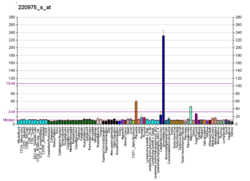C1QTNF1
Complement C1q tumor necrosis factor-related protein 1 is a protein that in humans is encoded by the C1QTNF1 gene.[3][4]
Interactions
C1QTNF1 has been shown to interact with Arginine vasopressin receptor 2.[5]
References
- ↑ "Human PubMed Reference:".
- ↑ "Mouse PubMed Reference:".
- ↑ Innamorati G, Whang MI, Molteni R, Le Gouill C, Birnbaumer M (Oct 2002). "GIP, a G-protein-coupled receptor interacting protein". Regul Pept. 109 (1–3): 173–9. PMID 12409230. doi:10.1016/S0167-0115(02)00201-X.
- ↑ "Entrez Gene: C1QTNF1 C1q and tumor necrosis factor related protein 1".
- ↑ Innamorati, Giulio; Whang Michael Insuk; Molteni Raffaella; Le Gouill Christian; Birnbaumer Mariel (Nov 2002). "GIP, a G-protein-coupled receptor interacting protein". Regul. Pept. Netherlands. 109 (1–3): 173–9. ISSN 0167-0115. PMID 12409230. doi:10.1016/S0167-0115(02)00201-X.
External links
- Human C1QTNF1 genome location and C1QTNF1 gene details page in the UCSC Genome Browser.
- Human GIP genome location and GIP gene details page in the UCSC Genome Browser.
Further reading
- Innamorati G, Bianchi E, Whang MI (2006). "An intracellular role for the C1q-globular domain". Cell Signal. 18 (6): 761–70. PMID 16386877. doi:10.1016/j.cellsig.2005.11.004.
- Kim KY, Kim HY, Kim JH, et al. (2006). "Tumor necrosis factor-alpha and interleukin-1beta increases CTRP1 expression in adipose tissue". FEBS Lett. 580 (16): 3953–60. PMID 16806199. doi:10.1016/j.febslet.2006.06.034.
- Otsuki T, Ota T, Nishikawa T, et al. (2007). "Signal sequence and keyword trap in silico for selection of full-length human cDNAs encoding secretion or membrane proteins from oligo-capped cDNA libraries". DNA Res. 12 (2): 117–26. PMID 16303743. doi:10.1093/dnares/12.2.117.
- Rual JF, Venkatesan K, Hao T, et al. (2005). "Towards a proteome-scale map of the human protein-protein interaction network". Nature. 437 (7062): 1173–8. PMID 16189514. doi:10.1038/nature04209.
- Gerhard DS, Wagner L, Feingold EA, et al. (2004). "The status, quality, and expansion of the NIH full-length cDNA project: the Mammalian Gene Collection (MGC)". Genome Res. 14 (10B): 2121–7. PMC 528928
 . PMID 15489334. doi:10.1101/gr.2596504.
. PMID 15489334. doi:10.1101/gr.2596504. - Ota T, Suzuki Y, Nishikawa T, et al. (2004). "Complete sequencing and characterization of 21,243 full-length human cDNAs". Nat. Genet. 36 (1): 40–5. PMID 14702039. doi:10.1038/ng1285.
- Clark HF, Gurney AL, Abaya E, et al. (2003). "The secreted protein discovery initiative (SPDI), a large-scale effort to identify novel human secreted and transmembrane proteins: a bioinformatics assessment". Genome Res. 13 (10): 2265–70. PMC 403697
 . PMID 12975309. doi:10.1101/gr.1293003.
. PMID 12975309. doi:10.1101/gr.1293003. - Strausberg RL, Feingold EA, Grouse LH, et al. (2003). "Generation and initial analysis of more than 15,000 full-length human and mouse cDNA sequences". Proc. Natl. Acad. Sci. U.S.A. 99 (26): 16899–903. PMC 139241
 . PMID 12477932. doi:10.1073/pnas.242603899.
. PMID 12477932. doi:10.1073/pnas.242603899.
This article is issued from
Wikipedia.
The text is licensed under Creative Commons - Attribution - Sharealike.
Additional terms may apply for the media files.
